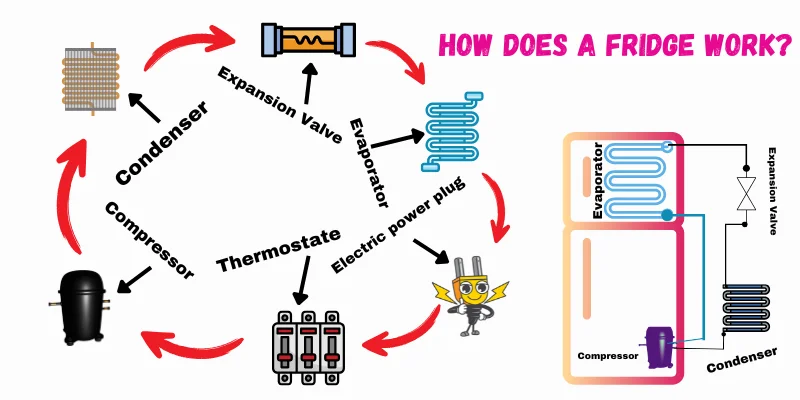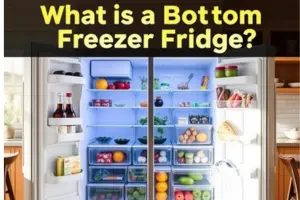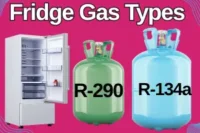How Does a Refrigerator Work?
Published: 12 Dec 2024
Have you ever opened your fridge and wondered, “How does this magical box keep my food fresh and cool?” Refrigerators are incredible machines that have revolutionized how we store and preserve food, ensuring convenience and promoting healthier lifestyles. Behind their simple appearance lies a fascinating process that uses science and technology to control temperature and protect food from spoilage.
In this guide, we’ll break down how refrigerators work in easy-to-understand terms. You’ll learn about the key components, such as the compressor and condenser, and how they work together in a seamless cycle. Plus, we’ll share maintenance tips to keep your fridge running smoothly for years to come.

Are you ready to explore this cool world of science and technology? Let’s get started!
1. What is a Refrigerator?
A refrigerator is a device that keeps food cool to prevent spoilage. It slows the growth of bacteria, helping food last longer and stay fresh.
- Definition: A fridge uses cooling to preserve food and drinks.
- Common Uses: Stores perishable items like fruits, vegetables, milk, and meats.
- How It Helps: Slows bacteria growth, keeping food safe and fresh.
Now that you know what a refrigerator is, let’s move on to why understanding how it works is so important!
2. Why is Understanding the Working of a Refrigerator Important?
Knowing how a refrigerator works can help you save energy and keep your fridge running smoothly. When you understand the basic components and how they work together, you can also avoid common problems and extend the life of your appliance.
- Energy Efficiency: A well-maintained fridge uses less energy, which can save you money on your electricity bill.
- Proper Maintenance: Understanding how the fridge works helps you take better care of it—cleaning, checking seals, and avoiding overloading.
- Prevent Problems: When you know how it functions, it’s easier to spot issues early, such as temperature fluctuations or strange noises.
Now that we understand why it’s important to know how a fridge works, let’s look at the key components inside your refrigerator that make all of this possible. Let’s move on!
3. Key Components of a Refrigerator
A refrigerator is made up of several key parts that work together to keep your food fresh and cool. Understanding how each part functions can help you take better care of your fridge and understand how it works. Here are the key components that play a major role in the cooling process:
- Compressor
- Condenser
- Evaporator
- Refrigerant
- Thermostat
- Expansion Valve
Let’s dive into each of these parts and explore what they do to keep the fridge functioning efficiently. We’ll explain each component in detail below.
3.1 Compressor
The compressor is the “heart” of the refrigerator. It compresses the refrigerant gas, turning it into a high-pressure, hot gas. This gas then flows to the next component, where it begins to cool down.
- Function: Compresses the refrigerant gas and pumps it into the condenser.
- Importance: Without the compressor, the refrigerant wouldn’t circulate through the system, and the cooling process would stop.
3.2 Condenser
The condenser is responsible for releasing the heat that the refrigerant absorbs from the inside of the fridge. It cools down the high-pressure refrigerant gas and turns it into a liquid.
- Function: Releases heat from the refrigerant gas as it cools down and condenses.
- Importance: Helps transform the refrigerant gas into a liquid, which is essential for the cooling process.
3.3 Evaporator
The evaporator is where the refrigerant absorbs heat from the fridge’s interior. It’s the part that keeps the fridge cool by removing warmth from the air inside.
- Function: Absorbs heat from the inside of the fridge and cools the air.
- Importance: Essential for maintaining a cold environment inside the fridge.
3.4 Refrigerant
Refrigerant is the fluid that flows through the refrigerator’s coils. It moves through the compressor, condenser, and evaporator, absorbing and releasing heat as it circulates.
- Function: Moves heat from inside the fridge to the outside, keeping the internal temperature low.
- Importance: The refrigerant is the key fluid that helps the fridge cool by carrying away heat.
3.5 Thermostat
The thermostat controls the temperature inside the refrigerator. It senses the temperature and signals the compressor to turn on or off as needed, maintaining the correct temperature.
- Function: Regulates the fridge’s temperature by controlling the compressor.
- Importance: Keeps the fridge from becoming too warm or too cold, ensuring food stays fresh.
3.6 Expansion Valve
The expansion valve plays a vital role in controlling the flow of refrigerant from the high-pressure side to the low-pressure side of the refrigerator. It helps regulate the amount of refrigerant entering the evaporator.
- Function: Reduces the pressure of the refrigerant, allowing it to expand and cool down.
- Importance: It controls the flow and pressure of the refrigerant, which helps ensure efficient cooling inside the fridge.
Now that we have explored the essential components of a refrigerator, we will shift our focus to the frequently asked questions that many people have regarding the workings of a fridge. These questions address common concerns and provide clarity on important aspects of refrigerator functionality. Let’s move ahead and explore these queries in more detail.
Common Questions About How Refrigerators Work
Here’s a list of some common questions about refrigerators that you may be curious about. These answers will help clarify how your fridge works and how you can keep it running efficiently.
- Why does a refrigerator need refrigerant?
- What happens if the compressor stops working?
- How does the thermostat control the temperature?
- Why is the freezer section colder than the refrigerator section?
- Can I put hot food in the fridge?
- What causes my fridge to make a strange noise?
- How often should I clean my fridge?
- How can I save energy while using my fridge?
The refrigerant is a fluid that circulates through the refrigerator’s system, absorbing and releasing heat. It allows the fridge to maintain a cold internal environment by removing heat from inside the fridge and expelling it outside. Without refrigerant, the cooling cycle wouldn’t be possible, and the fridge would not be able to maintain a cold temperature.
The compressor is responsible for circulating the refrigerant throughout the fridge. If the compressor stops working, the refrigerant cannot move through the system, meaning the fridge will no longer be able to cool. Without the compressor, the fridge won’t be able to regulate temperature, causing it to warm up and potentially spoil food.
The thermostat in a refrigerator monitors the internal temperature and signals the compressor to turn on or off as needed. When the temperature inside the fridge rises above the set level, the thermostat activates the compressor to cool the space down. When the desired temperature is reached, it shuts off the compressor, maintaining a steady internal temperature.
The freezer is colder because it is placed in a part of the fridge where the refrigerant has already absorbed heat from the main compartment. As the refrigerant cools down in the evaporator coils, the freezer gets more of the cold air. The refrigerator section is kept slightly warmer to maintain proper preservation temperatures for fresh food.
It’s not recommended to put hot food directly into the fridge. Hot food can raise the temperature inside the fridge, which can cause the appliance to work harder to cool down and potentially lead to food spoilage. It’s best to let hot food cool down before placing it in the fridge.
Fridges can make different noises for several reasons. Common causes include the compressor running, ice buildup in the freezer, or air moving through the ventilation system. If the noise is constant or very loud, it might indicate a mechanical problem, such as a faulty fan or compressor, and should be inspected.
You should clean your fridge regularly to maintain its performance. It’s a good idea to clean the interior every three to four months, wiping down shelves, drawers, and surfaces. You should also clean the condenser coils once a year, as dust and dirt can cause the fridge to overheat and reduce its efficiency.
To save energy, keep the fridge temperature set to around 37°F (3°C) and the freezer at 0°F (-18°C). Ensure the door seals are tight, and avoid leaving the door open for too long. Additionally, keep your fridge away from heat sources like stoves or direct sunlight, and avoid overloading it, as proper air circulation is key to efficient cooling.
Now we know the final conclusion of this article.
Conclusion
Now that you understand how a refrigerator works, you can appreciate the important role it plays in keeping your food fresh and safe. By knowing the key components and how they work together, you can maintain your fridge better, save energy, and prevent problems before they happen. A refrigerator is truly a clever invention that makes our lives easier, but it’s also important to take care of it.
If you have any questions or thoughts about how a fridge works, feel free to leave them in the comment section below! And don’t forget, there are many more interesting articles waiting for you. If you want to know more about refrigerators, check out related articles like “How to Use a Refrigerator for the First Time” or “The History of the Refrigerator.”
Let’s keep exploring the world of fridges together!





